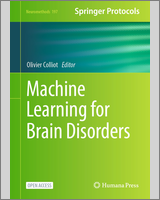| Abrol et al. [28] | ADNI | T1w | AD classification | FM visualization, Perturbation | 3.2, 3.4 |
| Bae et al. [32] | ADNI | sMRI | AD classification | Perturbation | 3.4 |
| Ball et al. [33] | PING | T1w | Age prediction | Weight visualization, SHAP | 3.1, 3.5 |
| Biffi et al. [29] | ADNI | T1w | AD classification | FM visualization | 3.2 |
| Böhle et al. [34] | ADNI | T1w | AD classification | LRP, Guided back-propagation | 3.3 |
| Burduja et al. [35] | RSNA | CT scan | Intracranial Hemorrhage detection | Grad-CAM | 3.3 |
| Cecotti and Gräser [26] | in-house | EEG | P300 signals detection | Weight visualization | 3.1 |
| Dyrba et al. [36] | ADNI | T1w | AD classification | DeconvNet, Deep Taylor decomposition, Gradient ⊙ Input, LRP, Grad-CAM | 3.3 |
| Eitel and Ritter [37] | ADNI | T1w | AD classification | Gradient ⊙ Input, Guided back-propagation, LRP, Perturbation | 3.3, 3.4 |
| Eitel et al. [38] | ADNI, in-house | T1w | Multiple Sclerosis detection | Gradient ⊙ Input, LRP | 3.3 |
| Fu et al. [39] | CQ500, RSNA | CT scan | Detection of Critical Findings in Head CT scan | Attention mechanism | 3.6 |
| Gutiérrez-Becker and Wachinger [40] | ADNI | T1w | AD classification | Perturbation | 3.4 |
| Hu et al. [41] | ADNI, NIFD | T1w | AD/CN/FTD classification | Guided back-propagation | 3.3 |
| Jin et al. [42] | ADNI, in-house | T1w | AD classification | Attention mechanism | 3.6 |
| Lee et al. [43] | ADNI | T1w | AD classification | Modular transparency | 3.6 |
| Leming et al. [31] | OpenFMRI, ADNI, ABIDE, ABIDE II, ABCD, NDAR ICBM, UK Biobank, 1000FC | fMRI | Autism classification Sex classification Task vs rest classification | FM visualization, Grad-CAM | 3.2, 3.3 |
| Magesh et al. [44] | PPMI | SPECT | Parkinson’s disease detection | LIME | 3.5 |
| Martinez-Murcia et al. [30] | ADNI | T1w | AD classification Prediction of neuropsychological tests & other clinical variables | FM visualization | 3.2 |
| Nigri et al. [45] | ADNI, AIBL | T1w | AD classification | Perturbation, Swap test | 3.4 |
| Oh et al. [27] | ADNI | T1w | AD classification | FM visualization, Standard back-propagation, Perturbation | 3.2, 3.3, 3.4 |
| Qiu et al. [46] | ADNI, AIBL, FHS, NACC | T1w | AD classification | Modular transparency | 3.6 |
| Ravi et al. [47] | ADNI | T1w | CN/MCI/AD reconstruction | Modular transparency | 3.6 |
| Rieke et al. [48] | ADNI | T1w | AD classification | Standard back-propagation, Guided back-propagation, Perturbation, Brain area occlusion | 3.3, 3.4 |
| Tang et al. [49] | UCD-ADC, Brain Bank | Histology | Detection of amyloid-β pathology | Guided back-propagation, Perturbation | 3.3, 3.4 |
| Wood et al. [50] | ADNI | T1w | AD classification | Modular transparency | 3.6 |
